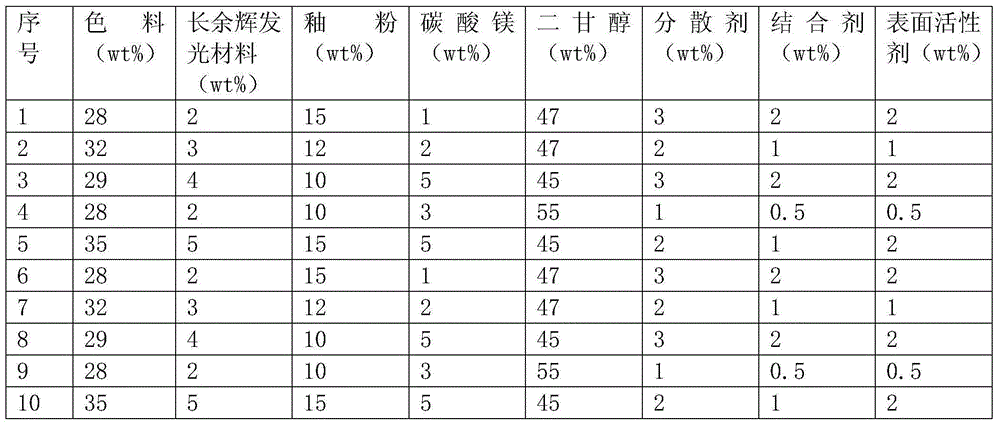Color-glazed mixed luminous ink for inkjet printing of ceramics and preparation method thereof
A ceramic inkjet and hybrid technology, applied in the field of ceramic tile decoration, can solve the problems of low transparency of luminous glaze, not suitable for inkjet printing layer protective layer, etc., to achieve enhanced suspension stability, excellent color development effect, and energy saving Effect
- Summary
- Abstract
- Description
- Claims
- Application Information
AI Technical Summary
Problems solved by technology
Method used
Image
Examples
Embodiment 1-10
[0033] The component formulations of the color-glazed mixed-type luminous materials for ceramic inkjet printing provided in Examples 1-10 are shown in Table 1 below.
[0034] Table 1
[0035]
Embodiment 1
[0036] The color material selected in Example 1 is praseodymium yellow, and the long afterglow luminescent material is selected as aluminate-based long afterglow luminescent material SrAl 2 o 4 : Eu, Dy (green fluorescence), the color of the prepared ink is yellow, and the fluorescence lasts for ≥4 hours after the environment changes from light to dark. In this embodiment, the mass percentages of the chemical components of the glaze powder are: silicon dioxide: 45% to 50%; aluminum oxide 18% to 22%, ferric oxide: ≤0.2%; titanium dioxide: ≤0.3%; calcium oxide 8%~12%; Magnesium Oxide 4%~5%; Potassium Oxide: 1%~3%; Sodium Oxide: 3%~5%; Barium Oxide: 2%~4%; Zinc Oxide: 1%~2%; Zirconia: 1% to 2%; Loss on ignition: ≤1%; Water: ≤0.5%. Through the mass percentages of the above chemical components, those skilled in the art can calculate the dosage of the formula through the chemical analysis results of the Segel formula and the common mineral or frit raw materials used in ceramic pro...
Embodiment 2
[0053] For the formula, see the mass ratio of each component given in Table 1. In this example, the pigments used are cobalt blue and spinel-based black pigments mixed at a mass ratio of 1:2. The ratio of the two can be matched according to the ink color required in actual use. , And if necessary, other pigments can also be added, such as: praseodymium yellow, red brown, orange and so on. The long afterglow luminescent material is selected as the aluminate-based long afterglow luminescent material "CaAl 2 o 4 :Eu,Nd" (blue fluorescence) and "Sr 4 al 14 o 25 :Eu,Dy” (blue fluorescence) is prepared by mixing at a mass ratio of 1:3.
[0054] In this example, the preparation method is basically the same as that in Example 1, except that the raw materials of the colorant used in this example are pre-calcined before use. Specifically: the cobalt blue and spinel black pigments are calcined at a temperature of 700-850 ° C, and the particle size reaches 325 mesh. The standard ana...
PUM
| Property | Measurement | Unit |
|---|---|---|
| density | aaaaa | aaaaa |
| boiling point | aaaaa | aaaaa |
| diameter | aaaaa | aaaaa |
Abstract
Description
Claims
Application Information
 Login to View More
Login to View More - R&D
- Intellectual Property
- Life Sciences
- Materials
- Tech Scout
- Unparalleled Data Quality
- Higher Quality Content
- 60% Fewer Hallucinations
Browse by: Latest US Patents, China's latest patents, Technical Efficacy Thesaurus, Application Domain, Technology Topic, Popular Technical Reports.
© 2025 PatSnap. All rights reserved.Legal|Privacy policy|Modern Slavery Act Transparency Statement|Sitemap|About US| Contact US: help@patsnap.com

